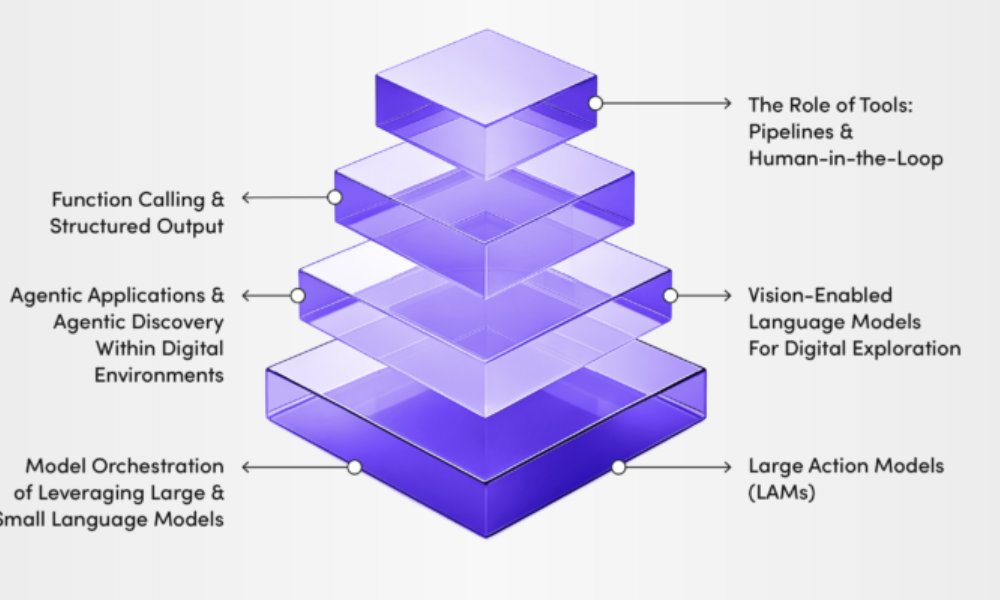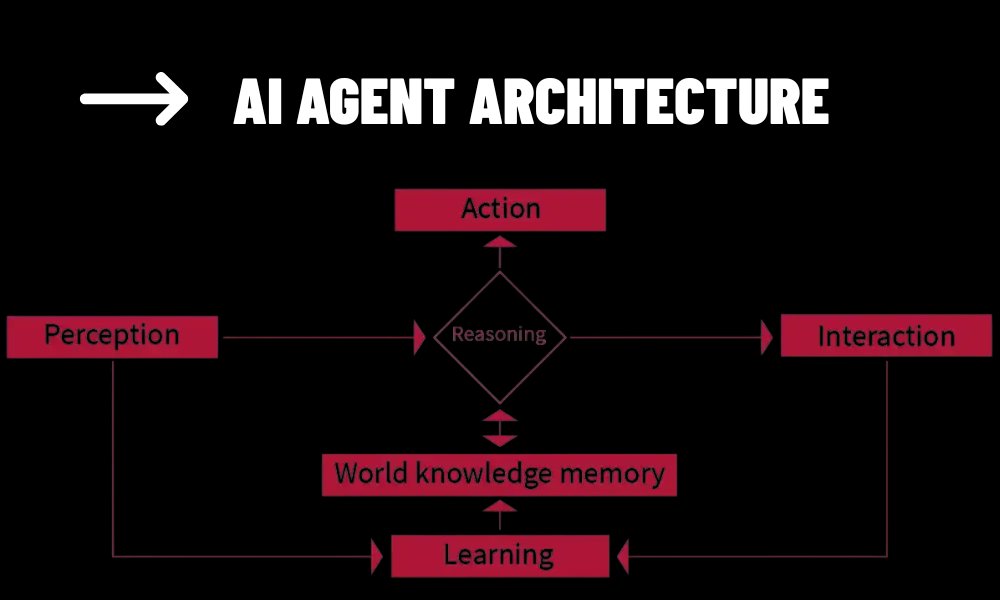What is an AI Agent?
An AI agent is an entity that perceives its environment through sensors, reasons based on that data, and then performs actions through actuators to achieve its objectives. The key goal of an AI agent is to maximize its performance according to a predefined set of rules, goals, or objectives. The agent’s behavior is determined by its architecture, which guides its decision-making process.
In simple terms, an AI agent functions like a virtual mind that interacts with the physical world (or a digital environment) to make decisions and perform tasks.
Core Components of AI Agent Architecture
The architecture of an AI agent typically consists of several key components that work together to enable intelligent behavior. Here are the fundamental elements of AI agent architecture:
1. Perception (Input Processing)
The perception component is responsible for gathering data from the environment. This is achieved through sensors or input devices that capture information such as visual data, auditory input, temperature, or motion. For example:
Cameras and LiDAR sensors are used in autonomous vehicles to perceive the road and surroundings.
Microphones are used in voice assistants to perceive spoken commands.
The perception component acts as the agent’s “sense” and provides raw data to be processed and analyzed in the next stages.
2. Decision-Making (Processing and Reasoning)
Once the agent has gathered information about the environment, it needs to process this data to make decisions. The decision-making component is the brain of the agent. This can involve multiple techniques and methods, including:
Rule-Based Systems: Where actions are based on predefined rules or logic.
Machine Learning: In which the agent uses supervised learning, unsupervised learning, or reinforcement learning to analyze data and optimize its actions.
Search Algorithms: These help the agent evaluate possible actions by exploring various state-space representations (e.g., depth-first search, breadth-first search).
Planning and Optimization: AI agents often need to plan sequences of actions over time to achieve long-term goals, using techniques like Markov decision processes or genetic algorithms.
This decision-making process enables the agent to reason about its environment and determine the best possible action to take.
3. Action (Output and Execution)
Once the agent has reasoned about the environment and made a decision, it needs to execute that decision by taking action. This is the output phase where the AI agent performs physical or digital actions through actuators. These actuators could range from a robotic arm in a manufacturing plant to a software command executed by a virtual assistant.
For example:
Robots use motors, actuators, and other physical components to interact with the environment.
Autonomous vehicles use steering, braking, and acceleration mechanisms to navigate the road.
The action component ensures the agent interacts with the world in a meaningful way, based on its goals.
4. Learning (Adaptive Behavior)
One of the defining characteristics of AI agents is their ability to learn from their experiences. The learning component enables the agent to improve its performance over time. There are several types of learning strategies used in AI agents:
Supervised Learning: The agent learns from labeled data provided by a human or another system.
Unsupervised Learning: The agent learns from data that is not labeled, trying to identify patterns on its own.
Reinforcement Learning: The agent learns by interacting with the environment, receiving feedback in the form of rewards or penalties based on the actions it takes.
This component allows the AI agent to adapt to new situations and improve its decision-making abilities based on experience.
5. Memory and Knowledge Base
For an AI agent to make informed decisions, it requires a memory or knowledge base to store and retrieve information. This memory can hold past experiences, data points, or strategies that the agent has encountered. There are two types of knowledge that an agent might store:
Short-Term Memory: Temporary storage of information for immediate tasks.
Long-Term Memory: More permanent storage of knowledge, like strategies or learned behaviors.
This component enables the agent to reason about past actions and use that information to make better decisions in the future.
6. Communication (Interaction with Other Agents)
In some cases, an AI agent needs to interact with other agents or humans to achieve its objectives. The communication component allows the agent to exchange information with others, either directly (through natural language processing or other methods) or through a network.
For example:
Multi-agent systems involve several agents collaborating or competing to achieve specific goals, like in distributed robotic teams or swarm intelligence.
Chatbots and virtual assistants rely on communication with humans to perform tasks like answering questions or managing schedules.
Effective communication enables AI agents to work together and coordinate actions, particularly in complex systems.

How Does AI Agent Architecture Drive Performance?
The true power of an AI agent lies in how well these components work together. Each stage influences the others, creating a dynamic feedback loop that allows the agent to perform intelligently in a wide variety of scenarios.
For instance, consider a robot vacuum. The robot begins by perceiving the environment through its sensors, detecting dirt or obstacles. It then processes this information to decide on the most efficient cleaning path. Once the path is determined, it executes the movement, cleaning the floor while avoiding objects. As it learns from previous cleaning sessions, the robot improves its efficiency, adapting to different layouts of rooms over time.
This interplay between perception, decision-making, action, and learning is what makes AI agents effective. It allows them to deal with uncertainty, adapt to changing conditions, and continually improve their performance.
The Role of Memory and Knowledge in AI Agents
Another essential feature of advanced AI agent architectures is their ability to store and retrieve information. Memory and a knowledge base enable agents to remember past actions and the outcomes of those actions. This stored information is crucial for learning, decision-making, and adapting to new environments.
In many systems, this memory can be long-term or short-term, allowing the agent to store relevant information for immediate tasks or retain strategies for more complex scenarios. For example, a self-driving car must remember traffic rules, previous trips, and route preferences to navigate safely and efficiently. Similarly, a customer service chatbot uses stored knowledge to answer common inquiries more accurately over time.
Communication in Multi-Agent Systems
Some AI agents interact not only with their environments but also with other agents. In a multi-agent system, AI agents work together or even compete to achieve a collective goal. For instance, in robotics, multiple agents might collaborate to carry out tasks like assembling products or delivering packages.
Effective communication between agents is crucial in such systems, enabling them to share information, coordinate actions, and optimize outcomes. This is particularly important in dynamic environments, where decisions must be made in real-time based on ongoing interactions with both the environment and other agents.
Challenges and the Future of AI Agent Architecture
Designing efficient AI agent architectures isn’t without its challenges. One of the main difficulties is creating systems that can deal with complex, real-world environments where uncertainty and unpredictability are common. It’s also a challenge to ensure that AI agents make decisions that are not only intelligent but also ethical and transparent. Bias in decision-making models or data security concerns are significant issues when it comes to deploying AI in sensitive fields like healthcare or autonomous vehicles.
However, the future of AI agent architecture is bright. As machine learning algorithms continue to improve, AI agents will become more adaptive and capable of handling increasingly sophisticated tasks. The integration of edge computing and 5G networks will also allow agents to operate more efficiently in real-time, processing data faster and with lower latency.
The Role of AI Agent Architecture in Shaping Intelligent Systems
AI agent architecture is the backbone of intelligent systems. It determines how agents perceive the world, make decisions, act upon those decisions, and learn from experiences. As the technology continues to evolve, AI agents will become even more autonomous, efficient, and capable of solving increasingly complex problems.
Understanding the architecture behind AI agents not only gives us insights into how these systems operate but also sheds light on how they can be used to enhance human capabilities and improve industries across the board. From healthcare to autonomous driving, AI agents are poised to change the way we interact with technology, driving us towards a smarter, more connected future.

